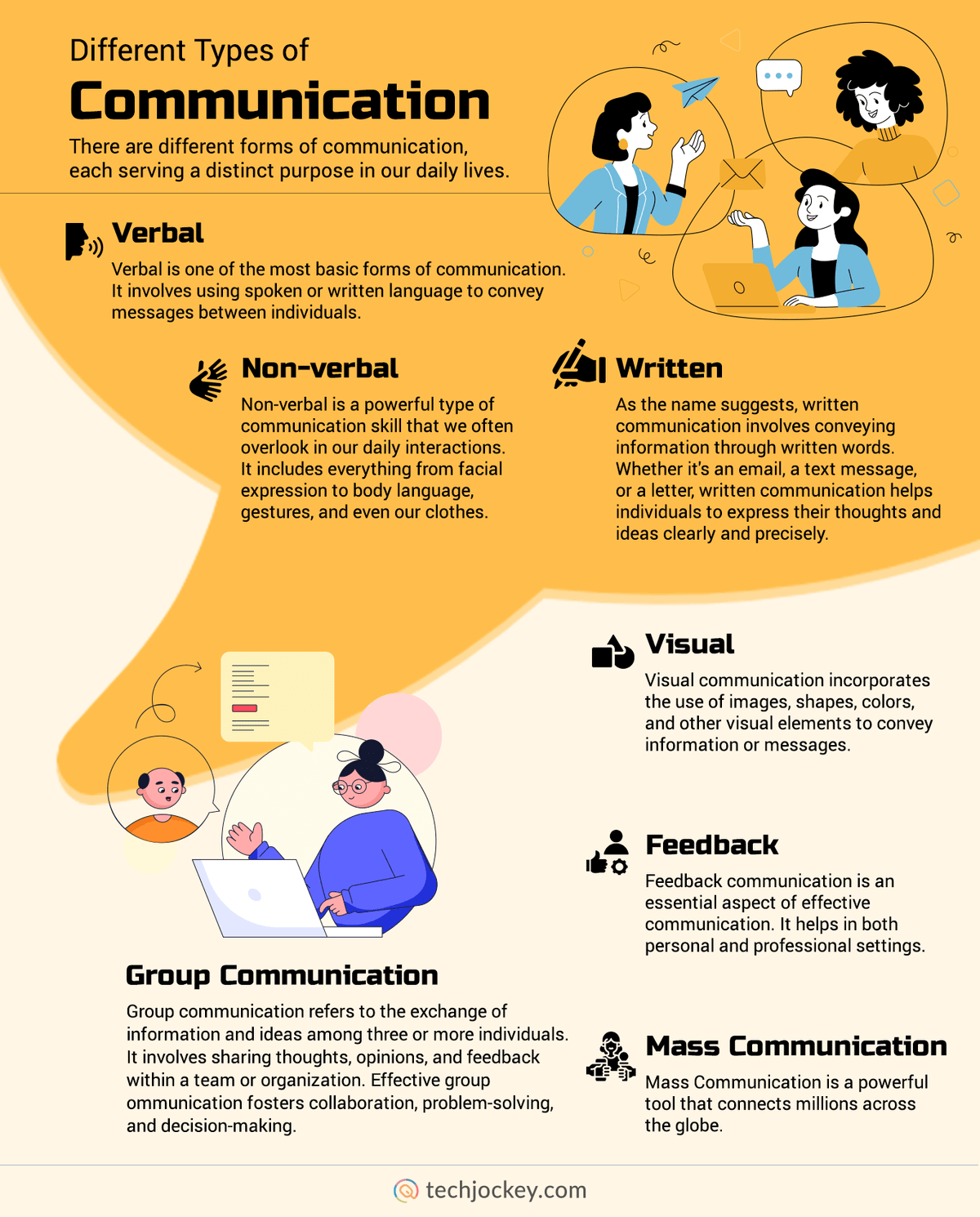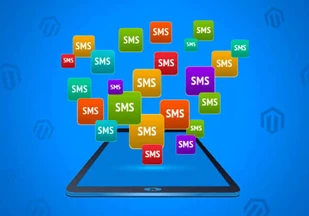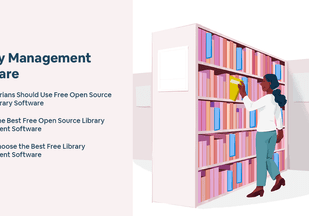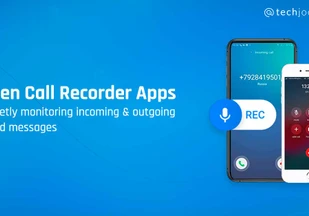Summary: Let’s explore the seven types of communication: verbal, non-verbal, written, feedback, visual, group, and mass. Through examples like speaking, body language, emails, and more, we delve into how each communication form plays a unique role in effective interaction.
Communication is a fundamental aspect of human existence. From the moment we are born, we rely on various forms of communication to express our thoughts and emotions. While many of us think of communication simply as speaking or writing, it encompasses much more than that.
In fact, there are seven different types of communication that help us navigate through life and connect with others in meaningful ways. In this article, we will explore these different kinds of communication and provide real-life examples to help you understand how they manifest in our daily interactions.
Table of Contents
What is Communication?
Before going any further, let’s first understand what communication really is. It is not only speaking with someone on the phone or sending an SMS. Communication is the lifeblood of human interaction, connecting people from all walks of life.
It is the art of exchanging information and ideas between individuals or groups through various mediums such as speech, writing, body language, and now even technology. It circles everything from nonverbal cues like facial expressions and tone of voice to written messages.
In simple terms, from simple gestures and spoken words to sending emojis to your friends, communication takes many forms.
Why Communication Plays an Important Role in Business?
Communication plays a crucial role in the success of any business. Here are six key reasons why:
- Effective communication fosters teamwork and collaboration: Clear and open communication ensures that all team members understand their roles, objectives, and tasks. Clear communication often promotes cooperation and teamwork among employees.
- Communication enhances decision-making: By sharing relevant information and exchanging ideas, you can ensure that all stakeholders are on the same page. Effective communication enables informed decision-making and minimizes misunderstandings or conflicts.
- Good communication builds trust and bonds: Regularly sharing updates, offering feedback, and actively listening to employees creates a sense of trust, respect, and loyalty within the organization.
- Communication improves productivity: Clear communication channels facilitate efficient coordination of tasks, reducing misunderstandings or delays that can hinder work progress. This automatically enhances productivity among employees.
- Effective communication strengthens client relationships: Communicating effectively with clients builds trust, ensures that expectations are met, and increases customer satisfaction.
- Communication resolves conflicts: Clear and concise communication enables prompt resolution of conflicts. It prevents issues from escalating, maintaining a positive work environment.
What are the Different Types of Communication?


There are different forms of communication, each serving a distinct purpose in our daily lives.
Verbal Communication
Verbal is one of the most basic forms of communication. It involves using spoken or written language to convey messages between individuals. This type of communication includes face-to-face conversations, phone calls, video conferences, etc.
Imagine a scenario where you are having lunch with your best friend. You engage in casual talk about your day while sharing laughter over funny incidents– this is an example of verbal communication with face-to-face conversation and sharing experiences.
Advantages and Disadvantages of Verbal Communication
| Advantages | Disadvantages |
| Real-time communication | Language barriers |
| Quick and easy way of communication | Misinterpretation in verbal communication |
| Immediate communication | |
| Builds personal touch and trust | |
| Immediate clarification |
Software to Improve Verbal Communication
Improving verbal communication skills is crucial for personal and professional growth. Here are some software and platforms that might help:
- CloudTalk for speech analysis
- Rian LangTech for language translation
- Murf AI for AI voice generation
- WellSaid for text-to-speech generation
Non-verbal Communication
Non-verbal is a powerful type of communication skill that we often overlook in our daily interactions. It includes everything from facial expression to body language, gestures, and even our clothes. While verbal communication relies on words, non-verbal can convey meaning and emotions without saying a word.
For example, imagine you are in the classroom and answering questions, and the teacher raises an eyebrow as you answer a question. This non-verbal cue could indicate skepticism or doubt about your response and convey valuable feedback that cannot be expressed through words alone.
Advantages and Disadvantages of Non-Verbal Communication
| Advantages | Disadvantages |
| Universality and cross-cultural understanding | Difficulty in controlling or concealing emotions |
| Quick message transmission | Limited ability to convey detailed information |
| Provides immediate feedback | Long conversations aren’t possible |
| Conveys complex messages efficiently | |
| Complements and supports verbal messages |
Written Communication
As the name suggests, written communication involves conveying information through written words. Whether it’s an email, a text message, or a letter, written communication helps individuals to express their thoughts and ideas clearly and precisely.
For instance, imagine you are in the office and receive an email from your manager outlining the key points discussed during a recent meeting. This form of written communication helps you stay informed and also serves as a reference for future discussions.
Advantages and Disadvantages of Written Communication
| Advantages | Disadvantages |
| Permanent record of communication | Time-consuming |
| Reference for future use | No personal touch |
| Minimizes language barrier | Technical difficulties may arise |
| Ensures formality and professionalism | No non-verbal cues |
| Effective for sharing complex information |
Software to Improve Written Communication
Improving written communication can be achieved through various software tools. Here are a few of them:
- QuillBot for paraphrasing
- Grammarly for grammar checking
- Jasper AI for top AI content generation
- WordTune for content improvement
Visual Communication
Visual communication incorporates the use of images, shapes, colors, and other visual elements to convey information or messages. It’s a powerful tool that can quickly grab anyone’s attention and communicate complex ideas in a simple and engaging way.
One example of visual communication is the use of infographics. These eye-catching designs combine texts and visuals to present complex data in a simplified and easily digestible format.
Advantages and Disadvantages of Visual Communication
| Advantages | Disadvantages |
| Increases engagement and retention | Not so cost-effective |
| Appeals to a wider audience | Requires additional effort |
| Enhances brand recognition and recall | Dependency on technology |
| Fosters creativity and innovation | |
| Enables effective data representation |
Software to Improve Visual Communication
Here are some popular tools that can help you enhance your visual communication skills:
- Canva for online graphic designing
- Adobe Illustrator for professional illustration
- Figma for beginners to boost their creativity
- Mokker AI for AI graphic designing
Feedback Communication
Feedback communication is an essential aspect of effective communication. It helps in both personal and professional settings. It involves providing comments, suggestions, or opinions about someone’s performance or behavior to help them improve and grow.
For example, a manager might provide constructive feedback to an employee by acknowledging their performance. This type of communication encourages growth and development by offering specific suggestions for improvement.
Advantages and Disadvantages of Feedback Communication
| Advantages | Disadvantages |
| Promotes two-way interaction | Biases can influence feedback |
| Provides valuable insights | Feedback overload can be overwhelming |
| Improves learning and growth | |
| Increases an objective approach | |
| Improves relationships with customers and employees |
Software to Improve Feedback Communication
There are several software tools available that can help streamline feedback processes and make communication more efficient. Here are some popular options:
- Slack for team communication and feedback
- Microsoft Teams for video communication within team
- Trello for project management
- Asana for assigning tasks and roles
Mass Communication
Mass Communication is a powerful tool that connects millions across the globe. It involves spreading information to large audiences through various channels such as television, radio, newspapers, magazines, and online platforms.
For example, news broadcasters like CNN or BBC deliver breaking news stories from all corners of the world directly to your living room.
Advantages and Disadvantages of Mass Communication
| Advantages | Disadvantages |
| Rapid transmission and updates | Potential for misinformation and fake news |
| Ability to influence public opinion | Overwhelming volume of information |
| Creates a sense of global connectivity | Lack of personalization and individual attention |
| Powerful tool for advertising and marketing | |
| Enables the sharing of knowledge and educational content |
Software to Improve Mass Communication
- Email Marketing: Zoho Mail, FreshMarketer, Mail Merger Toolkit and more.
- Social Media Management: Cloud Social, Tweetdeck, Planable, etc.
- Podcasting Tools: Podcastle AI, Adobe Podcast, etc.
- Mass Messaging and SMS Marketing Tools: Whatso, WappBlaster, iRocket, etc.
- Video Sharing Platforms: Kernel Video Sharing, YouTube, Vimeo Pro etc.
Group Communication
Group communication refers to the exchange of information and ideas among three or more individuals. It involves sharing thoughts, opinions, and feedback within a team or organization. Effective group communication fosters collaboration, problem-solving, and decision-making.
For example, during a brainstorming session, team members openly share ideas and collectively work towards finding innovative solutions to a problem.
Advantages and Disadvantages of Group Communication
| Advantages | Disadvantages |
| Can convey diverse perspectives and views | Time-consuming |
| Shared workload and responsibilities | Chances of conflicts and disagreements |
| Improved decision-making through collective input | There can be unequal participation and contribution |
| More learning and creativity | |
| Opportunity for social interaction and bonding |
Software to Improve Group Communication
Improving group communication is essential for better collaboration and productivity. Several software tools can facilitate effective group communication. Here are some popular ones:
- G suite for workspace and real-time collaboration
- Zoom for online group video conferencing
- Cisco Webex for online collaboration
- Discord for group chat discussion
Tips for Effective Communication
Effective communication is an essential factor that can enhance relationships and boost productivity. Here are six practical tips to help you master the art of communication:
- Be an active listener, make sure to give your full attention, and show genuine interest in the speaker’s words and body language.
- Remember to use clear and concise language and avoid complex terms so that your message is easily understood by others.
- Maintain open body language and friendly facial expressions. It helps create a comfortable and welcoming environment for effective communication.
- Practice empathy by putting yourself in the other person’s shoes. Understand their perspective and respond with kindness and understanding.
- Be mindful of your verbal & non-verbal cues, such as voice tone, expressions, gestures, etc. They can significantly impact the message you convey.
- Provide constructive feedback by focusing on specific behaviors or actions, offering suggestions for improvement, and acknowledging their strengths.
Suggested Read: Formal and Informal Communication Types & Differences
Bottom Line
Effective communication is a vital skill in everyone’s life. Understanding the various types of communication can significantly enhance our ability to express ourselves and connect with others. By familiarizing ourselves with the nuances of verbal, nonverbal, written, visual, and mass communication, you can navigate different situations with confidence.
Whether it’s speaking clearly in a business meeting or interpreting body language during social interaction, refined communication skills empower us to build stronger relationships and achieve success in both personal and professional endeavors.
Mostly Asked Questions on Types of Communication
What are the types of communication?
The types of communication include verbal, written, non-verbal, group, mass, interpersonal, intrapersonal, and visual.
What are the four main types of communication?
The four main types of communication are verbal, non-verbal, written, and mass communication.
What are the three main elements of communication?
The three main elements of communication are the transmitter (source of the message), the channel (information conveyed), and the receiver (recipient of the message).
What are the basics of communication?
The basics of communication are speaking, listening, writing, and reading.
What are the parts of communication?
The parts of communication are source, signal, destination, storage, and message retrieval.
What are the principles of communication?
The communication principles are clarity, coherence, urgency, timeliness, correctness, conciseness, courteousness, and completeness.
Why is communication important?
Communication is important as it fosters understanding, builds relationships, enables collaboration, resolves conflicts, and facilitates the exchange of ideas and information.
What is the communication process?
The term “communication process” refers to the movement of information or a message from the sender to the recipient over a chosen channel.
What is the purpose of communication?
The purpose of communication is to share information, convey ideas, express thoughts or emotions, influence others, and establish connections or relationships.
What are the barriers to communication?
Barriers to communication can include language barriers, distractions, cultural differences, physical distance, noise, poor listening skills, etc.
What makes a good communicator?
A good communicator knows how to use language, comprehend their audience, and make connections with them at the appropriate moments.






































